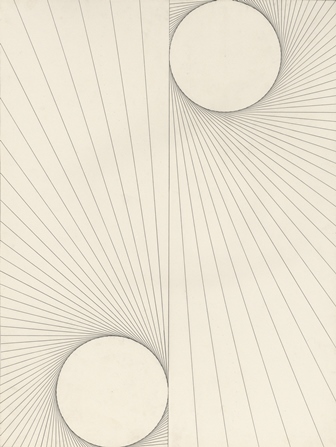The curatorial and editorial project for systems, non-
Art in the System
Viewpoint by D. W. Pike | July 2017
©Copyright Patrick Morrissey and Clive Hancock All rights reserved.
In 1930 Theo van Doesburg originated the term ‘Concrete Art’ to signify a theoretical
basis in solid and immutable mathematical reality, but from the perspective of almost
90 years later the name might also seem to have delivered on its implication of durability.
The persisting resonance of an art which refers to nothing but itself is perhaps
a consequence of that very self-
The Dresden-
In the East Germany of the ’60s and ’70s, abstraction was regarded as refusenik and
degenerate: only the exponents of Socialist Realism were permitted to function as
artists. Adler, meanwhile, was obliged to subsume his ideas into work that had an
ostensibly practical application, as architectural ornamentation. The book contains
striking photographs of a system he developed of interlinking mouldings – concrete
art in the most literal sense – that formed decorative faces on high-

Karl-
It was not until 1981 that Adler, by then aged 55, was first able to exhibit as an
artist, revealing a rich back catalogue of drawings and collages, some dating back
to the 1950s. Themes emerge across the decades: elements progressing through multiple
repetitions, the formation of curves from the gradual rotation of a repeating line
or shape; the production of geometries through layered transparency, using coloured
films, glass and semi-

Layering of semicircles, 1959. Collage, Ingres paper and graphite on card 26 3/4 x 26 3/4 in. Courtesy Galerie EIGEN + ART Leipzig/Berlin. Photo: Uwe Walter, Berlin]
The book contains a series of analytical drawings from the 1980s in which elegant gestalts emerge from systems of radiating, converging and intersecting lines – some straight, some arcing – which form grids, horizons and singularities. In other works, the same lines are used to dissect the rectangle of paper, and the component pieces rearranged to form new gestalts.

Karl-

Karl-

Karl-

Karl-
Painting, acrylic on particle board. Each panel 55 1/8 x 38 5/8 in. Courtesy Galerie EIGEN + ART Leipzig/Berlin. Photo: Herbert Boswank, Dresden]
This concept of the divided and reassembled whole is revisited in Adler’s object paintings from the 1990s and 2000s. Here the slices of square or rectangle reform as simple sculptural shapes, their minimalism in tension with the subtle and complex colouring. Transparent glazes overlay a gestural underpainting so that there is a kind of metaphor for the relationship between order and randomness in the contrast between the austere, precise geometry of the object and the seething energy of the painting.


Karl-
4 Sequences, Sheet 2, 1987. Drawing, graphite on card 31 7/8 x 24 in. Courtesy Galerie EIGEN + ART Leipzig/BerlinPhoto: Herbert Boswank, Dresden]
Karl-

Karl-
Max Bill and the Swiss Concretists in the 1930s saw their work not as aloof or mute
but as having a political dimension: an assertion of order amidst the chaos being
unleashed in surrounding countries and an expression of healthy ideological agnosticism
at a time of political fanaticism. Perhaps in the internet age this most empirical
way of thinking about art can make it a counterpoint to the data deluge of subjective
experiences and opinions, and the resulting blurring of truth and fiction. Adler’s
quiet revolt in single-
(1) System in der Kunst, Kunst im System/ The System in Art, Art in the System is published by Spector Books (text in German and English).